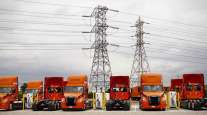Senior Reporter
NACFE: Fuel Efficiency Up 15% From 2009 to 2018

[Stay on top of transportation news: Get TTNews in your inbox.]
The average fleetwide fuel economy of trucks that participated in the North American Council for Freight Efficiency’s annual study increased 15% from 6.27 miles per gallon in 2009 to 7.27 mpg in 2018. On a year-over-year basis, the fuel economy of trucks increased .5%, from 7.23 mpg in 2017. NACFE released the results of its report Jan. 6.
NACFE worked with 21 North American fleets that operate Class 8 tractor-trailers, including day cabs and sleepers, in regional and longhaul operations to compile the study.
“Of course, we want it to be more than that, but it’s a pretty substantial increase year-over-year of the whole population of trucks in these fleets,” NACFE Executive Director Mike Roeth told Transport Topics. “We’re continuing to get better fuel-economy trucks, and that’s good.”

Roeth
Roeth said that while he’s pleased with the gains fleets are making, there is room for more improvement. But he says the strides are being hampered somewhat by increased speed. NACFE uses 65 mph as the threshold for its report, and the 2018 document showed that the number of fleets setting that limit as the top speed declined to 76% from an industry high of 94% in 2016.
Technology & Maintenance Council Executive Director Robert Braswell told TT that as truck engines have improved, the so-called sweet spot, the speed at which they perform at optimum levels, has increased to the mid-60 mph range.

Braswell
“That sweet spot has migrated to a higher speed. There are a lot of factors going on,” he said. “Does it eventually catch up with you? Yeah, I think so. Because whenever you get to that sweet spot, and you’re going over it, you’re going faster. You’re sacrificing fuel economy.”
Roeth said, “Some fleets are running faster than they used to. This new technology in the powertrain and the aerodynamics handles speed better. But there is still the science of, if you drive something this big through the air, faster, you’ll burn more fuel per mile.
“Not all fleets — and not all fleets in our study — increased their speed. So it’s kind of one step forward and a half a step back.”
Roeth says some of the factors increasing the speed of trucks include states that increased speed limits and the full implementation of electronic logging devices, which he believes puts more pressure on drivers to get to their destination on time.
“Drivers like driving faster,” he said.
The report said the price of fuel is another critical factor driving better fuel efficiency. The U.S. Department of Energy said the cost of diesel rose to $3.18 a gallon in 2018, when the study was taking place, from $2.65 a gallon in 2017. That’s an increase of 20%, or 53 cents in one year.

According to NACFE, the participating companies achieved the gains through the adoption of a variety of fuel-saving technologies. The group lists 85 technologies that qualify for inclusion, and carriers participating in the study used some or all of them, NACFE said. All of this equipment is commercially available; no prototypes or experimental technologies are included.
Fleet adoption of equipment to improve fuel efficiency increased from 17% in 2003 to 44% in 2018, the council said.
Technologies and techniques with the most significant jump in use in 2018 included:
- Predictive cruise control, 32% increase to 75.7% of fleets.
- Shifting to neutral, 29% increase to 70.1% of fleets.
- Low-rolling-resistance dual tires on tractors, 21% increase to 62% of fleets.
- Adding wheel covers to improve aerodynamics, 66% increase to 61.9% of fleets.
According to the report, some technologies are falling out of favor: • Real-time driver coaching to improve fuel economy, 12% decrease to 37.5% of fleets.
- Painting trucks a light color for less solar heat absorption, 18% decrease to 35.8% of fleets.
- Use of aluminum-wheel trailers, 30% decrease to 31.6% of fleets.
- Use of 2-speed/modulated cooling fan clutch, 10% decrease to 27.6% of fleets.
The cooling fans are located behind the radiator and draw cold air across the radiator and into the engine compartment, helping to reduce power consumption, according to the council.
NACFE says it has proved in its semi-annual Run on Less event that significant fuel-economy improvement still is to be made. The report noted with continued technological innovations being added to trucks, the average mpg could increase to between 8.3 and 10.1.
“In an ideal world, I think you can get to those kinds of numbers,” TMC Technical Director Jack Legler said. “It’s how fast you get something there, in the most economical fashion. It factors everything into it, labor, fuel. The bottom line is the bottom line.”
Want more news? Listen to today's daily briefing:




